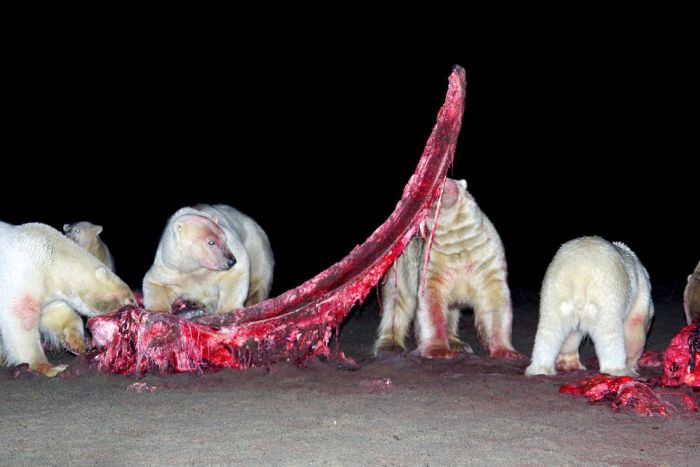|
|
Polar Bears Eating A Dead Whale, Alaska, United States
|
The polar bear is often regarded as a marine mammal because it spends many months of the year at sea. Its preferred habitat is the annual sea ice covering the waters over the continental shelf and the Arctic inter-island archipelagos. These areas, known as the "Arctic ring of life", have high biological productivity in comparison to the deep waters of the high Arctic. The polar bear tends to frequent areas where sea ice meets water, such as polynyas and leads (temporary stretches of open water in Arctic ice), to hunt the seals that make up most of its diet. Polar bears are therefore found primarily along the perimeter of the polar ice pack, rather than in the Polar Basin close to the North Pole where the density of seals is low.
Annual ice contains areas of water that appear and disappear throughout the year as the weather changes. Seals migrate in response to these changes, and polar bears must follow their prey. In Hudson Bay, James Bay, and some other areas, the ice melts completely each summer (an event often referred to as "ice-floe breakup"), forcing polar bears to go onto land and wait through the months until the next freeze-up. In the Chukchi and Beaufort seas, polar bears retreat each summer to the ice further north that remains frozen year-round.
The polar bear is the largest terrestrial carnivore, being more than twice as big as the Siberian Tiger. It shares the title of largest land predator (and largest bear species) with the Kodiak bear. Adult males weigh 350–680 kg (770–1500 lbs) and measure 2.4–3 m (7.9–9.8 ft) in length. Adult females are roughly half the size of males and normally weigh 150–249 kg (330–550 lb), measuring 1.8–2.4 metres (5.9–7.9 ft) in length. When pregnant, however, they can weigh as much as 499 kg (1,100 lb). The polar bear is among the most sexually dimorphic of mammals, surpassed only by the pinnipeds. The largest polar bear on record, reportedly weighing 1,002 kg (2,210 lb), was a male shot at Kotzebue Sound in northwestern Alaska in 1960.
|
|









